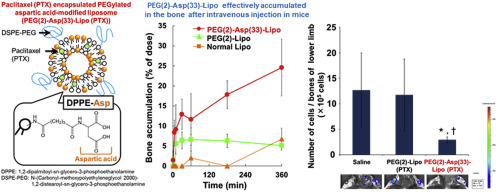当前位置:
X-MOL 学术
›
Biomaterials
›
论文详情
Our official English website, www.x-mol.net, welcomes your
feedback! (Note: you will need to create a separate account there.)
Development of PEGylated aspartic acid-modified liposome as a bone-targeting carrier for the delivery of paclitaxel and treatment of bone metastasis
Biomaterials ( IF 12.8 ) Pub Date : 2017-10-31 , DOI: 10.1016/j.biomaterials.2017.10.053 Shugo Yamashita , Hidemasa Katsumi , Nozomi Hibino , Yugo Isobe , Yumiko Yagi , Yuka Tanaka , Saki Yamada , Chihiro Naito , Akira Yamamoto
Biomaterials ( IF 12.8 ) Pub Date : 2017-10-31 , DOI: 10.1016/j.biomaterials.2017.10.053 Shugo Yamashita , Hidemasa Katsumi , Nozomi Hibino , Yugo Isobe , Yumiko Yagi , Yuka Tanaka , Saki Yamada , Chihiro Naito , Akira Yamamoto

|
To prevent bone metastasis, we developed polyethylene glycol (PEG)-conjugated aspartic acid (Asp)-modified liposomes (PEG-Asp-Lipo) as a bone-targeting carrier of paclitaxel (PTX) by using Asp-modified 1,2-dipalmitoyl-sn-glycero-3-phosphoethanolamine (DPPE-Asp). The affinity of Asp-modified liposomes to hydroxyapatite increased as the concentration of DPPE-Asp increased. The bone accumulation of [3H]-labeled PEG(2)-Asp(33)-Lipo was approximately 24.6% 360 min after intravenous injection in mice, in contrast to 5.4% and 6.7% of [3H]-labeled normal Lipo and PEG(2)-Lipo, respectively. Similarly, [14C]-labeled PTX encapsulated into PEG(2)-Asp(33)-Lipo predominantly accumulated in the bone. Furthermore, using an in situ imaging experiment, we observed that near-infrared fluorescence-labeled PEG(2)-Asp(33)-Lipo selectively accumulated in the bone near the joint after intravenous injection in mice. We also found that FITC-labeled PEG(2)-Asp(33)-Lipo predominantly accumulated on eroded and quiescent bone surfaces. In a bone metastatic tumor mouse model, in which B16-BL6/Luc cells were injected into the left ventricle of female C57BL/6 mice, metastatic bone tumor growth was significantly inhibited by an intravenous injection of PEG(2)-Asp(33)-liposomal PTX. In contrast, PEGylated liposomal PTX hardly affected the growth of metastatic bone tumors. These findings indicate that PEG(2)-Asp(33)-Lipo is a promising bone-targeting carrier for the delivery of PTX and treatment of bone metastasis.
中文翻译:

聚乙二醇化天冬氨酸修饰的脂质体作为骨靶向载体用于紫杉醇的递送和骨转移的治疗
为了防止骨转移,我们通过使用Asp修饰的1,2-二棕榈酰开发了聚乙二醇(PEG)结合的天冬氨酸(Asp)修饰的脂质体(PEG-Asp-Lipo)作为紫杉醇(PTX)的骨靶向载体。 -sn-甘油-3-磷酸乙醇胺(DPPE-Asp)。随着DPPE-Asp浓度的增加,Asp修饰脂质体对羟基磷灰石的亲和力也随之增加。小鼠静脉注射后[ 3 H]标记的PEG(2)-Asp(33)-Lipo的骨累积约为24.6%,而[ 3 H]标记的正常Lipo则为5.4%和6.7%和PEG(2)-Lipo分别。同样,[ 14 C]标记的PTX封装在PEG(2)-Asp(33)-Lipo中,主要聚集在骨骼中。此外,使用原位成像实验中,我们观察到在小鼠静脉注射后,近红外荧光标记的PEG(2)-Asp(33)-Lipo选择性地聚集在关节附近的骨骼中。我们还发现,FITC标记的PEG(2)-Asp(33)-Lipo主要积累在侵蚀的和静止的骨表面上。在向女性C57BL / 6小鼠的左心室注射B16-BL6 / Luc细胞的骨转移性肿瘤小鼠模型中,静脉注射PEG(2)-Asp(33)可显着抑制转移性骨肿瘤的生长。 -脂质体PTX。相反,PEG化脂质体PTX几乎不影响转移性骨肿瘤的生长。这些发现表明,PEG(2)-Asp(33)-Lipo是一种有前途的骨靶向载体,可用于PTX的递送和骨转移的治疗。
更新日期:2017-10-31
中文翻译:

聚乙二醇化天冬氨酸修饰的脂质体作为骨靶向载体用于紫杉醇的递送和骨转移的治疗
为了防止骨转移,我们通过使用Asp修饰的1,2-二棕榈酰开发了聚乙二醇(PEG)结合的天冬氨酸(Asp)修饰的脂质体(PEG-Asp-Lipo)作为紫杉醇(PTX)的骨靶向载体。 -sn-甘油-3-磷酸乙醇胺(DPPE-Asp)。随着DPPE-Asp浓度的增加,Asp修饰脂质体对羟基磷灰石的亲和力也随之增加。小鼠静脉注射后[ 3 H]标记的PEG(2)-Asp(33)-Lipo的骨累积约为24.6%,而[ 3 H]标记的正常Lipo则为5.4%和6.7%和PEG(2)-Lipo分别。同样,[ 14 C]标记的PTX封装在PEG(2)-Asp(33)-Lipo中,主要聚集在骨骼中。此外,使用原位成像实验中,我们观察到在小鼠静脉注射后,近红外荧光标记的PEG(2)-Asp(33)-Lipo选择性地聚集在关节附近的骨骼中。我们还发现,FITC标记的PEG(2)-Asp(33)-Lipo主要积累在侵蚀的和静止的骨表面上。在向女性C57BL / 6小鼠的左心室注射B16-BL6 / Luc细胞的骨转移性肿瘤小鼠模型中,静脉注射PEG(2)-Asp(33)可显着抑制转移性骨肿瘤的生长。 -脂质体PTX。相反,PEG化脂质体PTX几乎不影响转移性骨肿瘤的生长。这些发现表明,PEG(2)-Asp(33)-Lipo是一种有前途的骨靶向载体,可用于PTX的递送和骨转移的治疗。











































 京公网安备 11010802027423号
京公网安备 11010802027423号